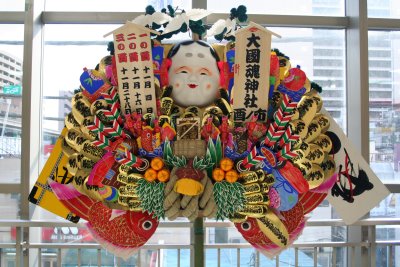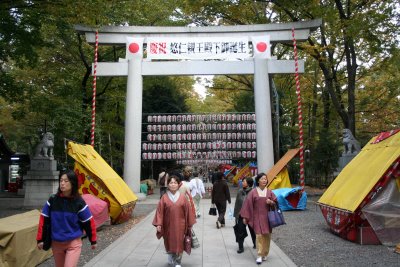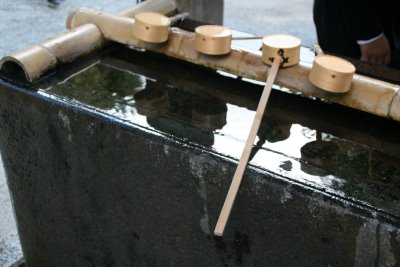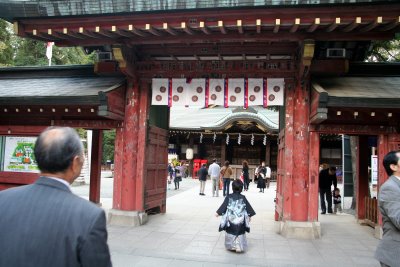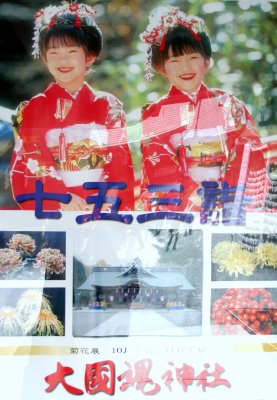January 14, 2009
Things to buy at the Shrine on Coming-of-Age Day
Daruma for sale. Buy one, make a wish, fill in one eye and then when the wish comes true fill in the other eye. They are taken to the temple on the first visit of the new year to be burned.
Caged balloon animals.
Bagged cotton candy.
Small punch balls filled with water. You don't really punch them, you pat them. You wrap the string around your finger and bounce them under your palm.
Posted by
Annie Donwerth Chikamatsu
at
8:45 PM
0
comments
![]()
Labels: Coming-of-Age Day, shrine
January 12, 2009
Coming-of-Age Day at Okunitama Shrine
Paper hanging from the torii.
See the young ladies in kimono? Check out the link and labels below for more information.
Kids Web Japan--Coming-of-Age Day
Posted by
Annie Donwerth Chikamatsu
at
8:18 PM
0
comments
![]()
Labels: Coming-of-Age Day, shrine
Behind the Scenes at the Shrine
Posted by
Annie Donwerth Chikamatsu
at
8:17 PM
0
comments
![]()
Labels: shrine
March 11, 2008
Another Detail of the Shrine
Click on the picture to enlarge. The grates along this walk had mesh over them to keep the little pebbles from falling through.
This curb is made of large stones.
Posted by
Annie Donwerth Chikamatsu
at
8:31 PM
0
comments
![]()
Labels: shrine
March 07, 2008
Bad Luck Bush
It's not really called a bad luck bush. At the shrine, people buy pieces of paper that have fortunes written on them. Most people tie their fortunes onto something. There is a place to tie them, but some people chose to tie them on this little bush for some reason. Click on the label below for more posts about shrines and temples. Click on the pictures to enlarge.
The bush is on the right of the entrance.
Posted by
Annie Donwerth Chikamatsu
at
9:57 PM
0
comments
![]()
March 05, 2008
Water Hose at Okunitama Shrine
Posted by
Annie Donwerth Chikamatsu
at
8:32 PM
0
comments
![]()
Labels: shrine
March 04, 2008
Okunitama Shrine
I only got one picture of a ume tree in bloom. Come to think of it, it was the only I saw! The blossoms were late this year. I haven't seen many trees in bloom in our neighborhood.
January 30, 2007
Street Shrine
It is not unusual to see shrines on the street. I thought this was a strange sight. That is a toilet next to the shrine. A house is being built and the workers need a toilet. I thought the location was unfortunate!
Posted by
Annie Donwerth Chikamatsu
at
9:27 PM
0
comments
![]()
Labels: shrine
January 01, 2007
Ringing in the New Year
Temple and shrine bells are rung on New Year's eve. Many people go and wait for a monk to ring in the new year. Several locations are televised. We go downstairs to Baba's house to watch on television. This bell is in Kyoto. A group of monks rang this bell. Can you see all the cables?
It was 12:00 when I took this picture. I think it was a few seconds after because I took time to say "akemashite omedetou gozaimasu". That takes time!
It is considered lucky to eat lots of soba during the New Year's holiday. Baba serves it right before midnight. We start to eat after the bell rings. Some people boil their own soba. We eat instant noodles. Perhaps that is not very traditional. Although, I did see a lot of people buying cup of noodles at the grocery store.
Little Brother was eating these. See the noodle trailing off out of the picture on the right? He's slurping it. His technique (angle) may be off a bit but slurping noodles is actually polite in Japan. In fact, you're not supposed to bite noodles. Soba shops are very noisy!
Kids Web Japan --temple and shrine bells
Posted by
Annie Donwerth Chikamatsu
at
11:21 AM
0
comments
![]()
Labels: food, New Year in Japan, shrine, temple
November 15, 2006
Shichi-go-san
This decoration was in the Fuchu station near Okunitama Shrine. November 15th is shichi-go-san which means seven, five, three. Seven-year-old girls, five-year-old boys (some three-year-old boys) and three-year-old girls dress up in traditional Japanese clothing or in their best clothes. They go to the shrine with their families.
Some girls go to the hairdresser to have their hair styled, especially if they are going to wear a kimono. Some have make-up put on. Most rent the kimono and an expert helps put it on. Some go to a professional photographer to have their pictures taken. People celebrate shichi-go-san in the weeks before the 15th especially if they need to reserve traditional clothing. Children are given sticks of milk candy. Families usually have a special meal.
Big Sister did not wear a kimono when she was 3. She refused. She wore a fancy dress. She wore a kimono when she was 7. Little Brother wore a boy's haori jacket and hakama trousers when he was 5. (There's a picture of a boy in them below.)
Kids WebJapan--shichi-go-san
Kids Web Japan-- kimono
Kids Web Japan--sticks of milk candy
Posted by
Annie Donwerth Chikamatsu
at
7:30 PM
0
comments
![]()
Labels: shichi-go-san, shrine
Entering the Shrine

This is the path to the shrine. The tall concrete structure is a tori. It is decorated for shichi-go-san. There are stalls of food along the way. The two women in the middle of the picture are wearing kimono with its traditional jacket.
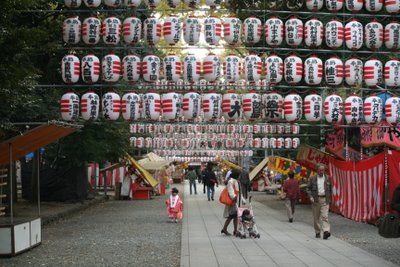
There are lanterns overhead. The names of sponsors are on the lanterns.

This little girl was walking toward me. She is in the picture above. Her mother said I could take her picture. She is three years old. You can tell by her size but also by her kimono. She's wearing a vest instead of an obi, sash.
Here is another three-year-old girl wearing a kimono.

This is the back of the lanterns.
Kids Web Japan-- shichi-go-san
Kids Web Japan--kimono
Posted by
Annie Donwerth Chikamatsu
at
6:56 PM
0
comments
![]()
Labels: decorations, holiday, shrine
Washing before Praying
At the end of the path of lanterns, you go through a gate.
At this shrine there was a place to wash your hands on the right.
The cups are used to pour water over your hands. I have seen people drink from them, too. I'm not sure if that is good manners or not.
Posted by
Annie Donwerth Chikamatsu
at
4:41 PM
0
comments
![]()
Labels: shrine
The Shrine
After washing your hands at Okunitama Shrine, you go through another gate. See the boy in the black and silver outfit? He is wearing a haori jacket. There is a hawk on the back. He is wearing hakama trousers, too. They are dificult to see. The trousers have wide legs so they look sort of like a skirt.
This is the main building. Weddings, ceremonies for babies, and ceremonies for shichi-go-san, etc, are held here in a large washitsu, room with (grass) mats. Actually, this is where Papa and I were married, where we had ceremonies for Big Sister and Little Brother, and where they had shichi-go-san. Funerals are not held here. They are held at temples.
Here is a detail of the roof.

Money is thrown in this big wooden box before you clap your hands and pray. That is a chrysanthemum on the front.
These were set here for shichi-go-san. There is another lantern on the other side. They have the chrysanthemum crest on them, too.
This poster was near the shop. Sorry there's so much glare. The sun wasn't even out!

To the right was a small shop. A small wooden tori leads to another building. There were displays of chrysanthemums today, too.
The shop sold these things. Silk prayer pouches for different purposes. Some are for good luck. Some are for good health. Some are for safe travels. Some are for bicycle safety.
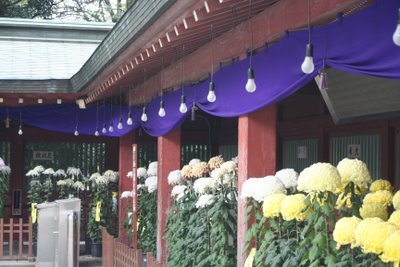
Chrysanthemum displays.
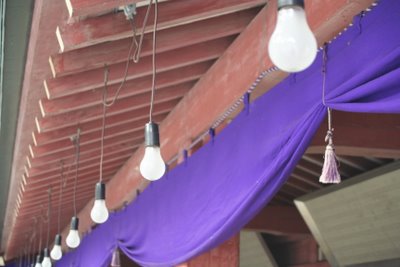
Fire hydrants. Click on the label below to see other fire hydrants.
Fortunes can be bought at that little shop. They are folded and tied here.
Those are wooden prayer plaques called enma on the right side of the picture. People write their wishes on them and hang them there.
Posted by
Annie Donwerth Chikamatsu
at
4:37 PM
0
comments
![]()
Labels: fire hydrants, holiday, shrine




















